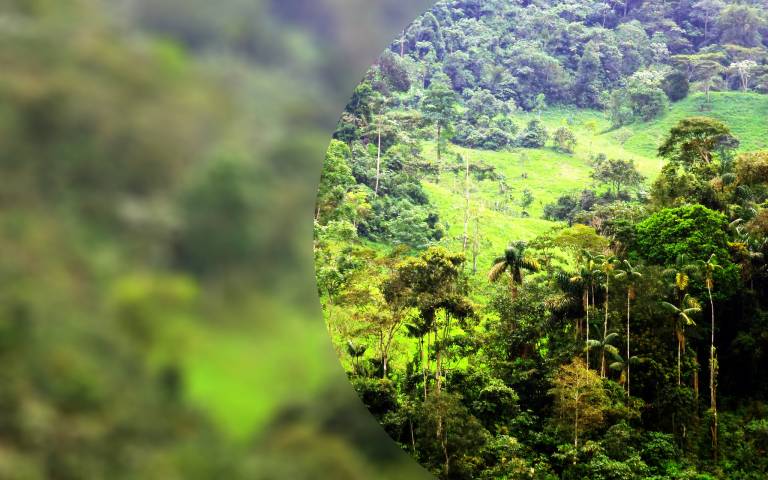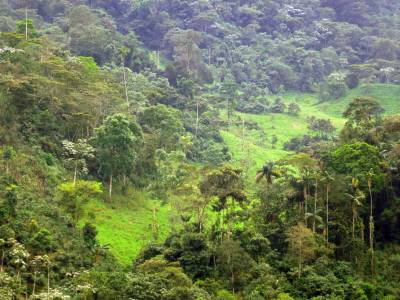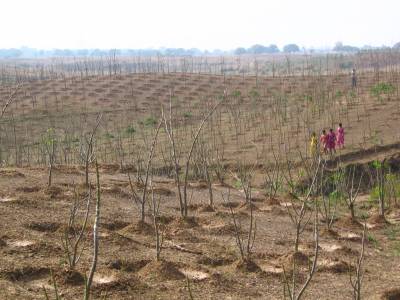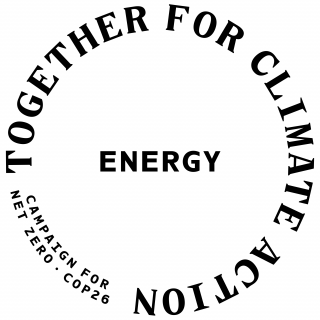How to ensure bioenergy and forest projects respect social justice
12 July 2021

At a glance
- To keep global warming to 1.5°C, we need to reach net-zero CO2 emissions by 2050. This means we have to rapidly reduce emissions but also increase the amount of carbon being stored in land.
- We have to stop deforestation and restore forests. We also probably need to grow crops for use as fuels in the energy system - “bioenergy.”
- If well-managed, these efforts can reduce CO2, improve ecosystems and bring economic benefits for communities. If poorly managed, they can have the opposite effects, and also threaten human rights.
- We must ensure that projects which aim to prevent deforestation, restore forests or grow bioenergy crops protect peoples’ rights to land, livelihoods, culture and development. This means carefully considering land management in areas where such projects take place, improving certification schemes for bioenergy and carbon offsetting, and calling for projects which centre social justice as well as carbon.
What is the issue?
We need to store large amounts of carbon in land
The Paris Agreement set the international community a target to limit the global temperature increase to 1.5°C. To achieve this, we have to radically reduce emissions from every area of human activity. Countries are making progress, but the speed of change required is challenging and cutting emissions in some areas, such as agriculture, is difficult. As a result, just trying to cut emissions is likely to be insufficient. We also need to remove CO2 from the atmosphere in huge quantities, in order to reach ‘net-zero’ by 2050.
One obvious solution is to grow more plants, as they absorb CO2 from the air as they grow. If trees and soil are left undisturbed, this carbon stays locked away in the plants and the soil. At the moment, the main options for removing CO2 involve planting new forests, restoring degraded ones and, importantly, halting deforestation.
Another solution is to plant and harvest fast growing crops, which can be made into transport fuels or used to generate electricity. In the 2000s, there was a surge of interest in using sugarcane and maize for biofuels for cars and trucks. There is now substantial interest in growing specific “energy crops”, such as miscanthus grass, willow or eucalyptus trees. When these are burnt in power stations, instead of allowing the CO2 that is produced back into the atmosphere, we can capture it and store it underground. This process is known as ‘bioenergy with carbon capture and storage’. If it is done well, the process can store more carbon than is released overall, i.e. it can be ‘carbon negative’.
The speed and scale of the changes threaten human rights
This may sound simple – just plant more trees and grow more crops! Indeed, many governments are planning to do just that. Better forestry can also bring other benefits, including increasing biodiversity, improving water quality, preventing soil erosion and more. New energy crops can also provide income for farmers.
However, the speed and scale of the changes being envisaged are enormous. Limiting global warming to 1.5°C could mean expanding forests by as much as 9.5 million km2 – an area approximately equivalent to the size of China – and converting up to 7 million km2 to produce energy crops by 2050. This means a radical transformation of our global land-use system over the next three decades. These huge shifts carry significant social risks. History shows that rapid, large-scale changes to land-use often have negative impacts on local communities. The people who farm the land or live in the forests are often not fully included in decision-making processes. This puts their rights to food, livelihoods, and self-determination at risk.
Because land is fundamental to people’s survival and identity, attempts to implement carbon solutions that are not fair and inclusive often lack public support, and therefore run the risk of protest and failure. While urgent action to address climate change is clearly needed, it must not threaten the rights and needs of people, or exacerbate existing injustices.
What are the key characteristics of the issue?
Many of the risks associated with land-based carbon storage stem from the many competing uses for land.
Land and forestry are strongly linked to local economies
The need to protect and expand forests has been long understood, yet deforestation and forest degradation remain common and hard to tackle. Trees are cut for timber, to clear space for agriculture, mining, roads and settlements, and wood is gathered for cooking. Some of this is large-scale industrial activity, while some is the activity of local communities. Some provides livelihoods and goods for people in the immediate vicinity, while some supplies international commodity markets. Globally, the biggest causes of deforestation are people clearing space for beef cattle, the production of oil seed crops (oil palm and soy bean), and cutting trees for paper and wood.
In these ways, deforestation is linked to strong local economic drivers. Economics are also highly relevant for forest expansion, as countries decide whether to pursue commercial tree plantations or support the regeneration of natural forests. If the economic concerns are ignored, deforestation will continue or simply be displaced – i.e. even if it is prevented in one location it will occur somewhere else – and reforestation programmes will not work. This will affect rural livelihoods negatively and could potentially even increase emissions.
A globalised world: policies and investments affect communities many miles away
In the 2000s, the EU and the US adopted policies to promote the use of biofuels for vehicles. While the aim was to reduce carbon emissions, this quickly increased global demand for crops such as sugarcane, maize and oil palm, which in some instances led to displacement of food crops and caused prices to rise.
The local impacts of international policies are also becoming clear in relation to carbon offsetting with forestry. Many companies, individuals and governments in the Global North are increasingly looking to invest in forest restoration in order to ‘offset’ their emissions. Many of these projects are in the Global South, where land and degraded forests are assumed to be plentiful, cheap, and available. While mutual benefits can occur, they can also introduce a power imbalance that tends to see the voices of local communities ignored or under-represented.
This dynamic is clear in the case of the Alto Mayo rainforest in Peru. In this area, which is a designated national park, there was rampant deforestation for logging and by farmers clearing land for coffee plantations. In 2008, the organisation Conservation International, backed financially by Disney and supported by the national government, undertook to reduce deforestation by changing farming practices in the area. Disney received ‘carbon credits’ for the CO2 that was saved and used these to improve its public image. The efforts were partially successful, with several farmers switching to honey and dragon fruit crops which require less land, and the creation of a bird sanctuary. However, the involvement of international funds led to a crackdown on activities in the park, which inflamed tensions, divided the local community and resulted in violent conflict.

Photo credit: Bruno Locatelli/CIFOR (flickr) - Alto Mayo, Peru

Land is often not as empty as it might seem
To avoid competition with food production, many studies recommend the use of ‘marginal’ land for energy crops. This is land that is either degraded or considered otherwise unusable. For both energy crops and forest projects, asking ‘who is using the land?’ and ‘what do they use it for?’ is crucial. Even poor quality agricultural land, grasslands and scrubland may be supporting livelihoods and biodiversity, have cultural significance, or be inhabited by groups who are already marginalised.
This was the case in South India, where the government legislated to encourage the production of jatropha. This crop can grow in poor quality soil and is used to make biodiesel. The aims were multiple - to improve agricultural production, create jobs to reduce rural poverty, mitigate climate change and improve energy supplies for the country. The government decided that the jatropha should be produced on areas that had been designated as ‘wastelands’, due to their supposed low productivity. But studies now show that those areas in fact already supported dynamic economies based on a crop called prosopis, and that the switch to jatropha caused a reduction in rural jobs and industries, negatively impacting the very people it was meant to support.

Photo credit: World Agroforestry Centre/V. P. Singh (flickr) – Jatropha on ‘wastelands’, India

Large-scale land acquisitions
A rapid increase in demand for land for forest and energy crops also risks driving large-scale land acquisitions. When large areas of land are bought quickly, smallholders can become uncompetitive, farmers risk losing livelihoods and being displaced, and communities can be broken up. Women are often more affected as the land they use to provide food for their households can be categorised as ‘empty’, and their land rights are often less well recognised. Many large-scale land acquisitions have been associated with energy crops in recent years, especially jatropha, sugarcane and eucalyptus in Sub-Saharan Africa, and similar impacts are expected for forestry land acquisitions.
What are the solutions?
Reduce emissions at source
The social risks associated with land-based carbon storage should lead those responsible for high CO2 emissions to work even harder to reduce emissions where they occur. Increasing the effort to reduce the CO2 associated with the consumption of goods, heating, travel and other services in developed countries can reduce the global pressure for ‘offsets’ on land elsewhere.
Remove the incentives for deforestation
To stop deforestation, we must address its drivers. Globally, we must reduce demands for commodities such as paper, beef and soybeans. One solution may be to intensify agriculture, though this can lead to other environmental impacts. Importantly, communities that rely on activities that cause deforestation need economically viable and culturally appropriate alternatives. Examples include programmes to provide electric stoves to replace firewood in cooking, and support for green industries to reduce logging.
Take a holistic view of rural landscapes
Simplistic categorisations of land are dangerous as they can easily overlook local issues and ignore the multiple roles that land can play in supporting livelihoods, food production, and nature simultaneously. Attempting to ensure that new forestry works for both nature and people, international organisations are now promoting the concept of Forest Landscape Restoration. Rather than focussing on single issues such as carbon storage or biodiversity, this seeks to restore an area’s full set of ecological functions, involving local stakeholders in order to balance the whole mosaic of agricultural and natural systems.
Support land governance that emphasises community involvement
Land governance – the rules, processes and structures through which decisions about land are made – must involve the genuine participation of local people. This must include women and other marginalised groups who are often left out of decision-making processes. Such participation will help to ensure that areas where bioenergy and forestry are planned can deliver better, more equitable outcomes for all.
Ensure bioenergy and carbon offsetting schemes prioritise social issues
As the global market for biomass develops and groups invest in forestry projects across the world, it is vital that these projects deliver benefits to local communities. Social factors, such as livelihoods and community involvement in decision-making, must be prioritised in certification schemes, and in all conversations surrounding bioenergy and carbon offsetting.
What is stopping the solutions being implemented?
These solutions require us to recognise that often several groups have competing claims over land. For example, local communities, regional authorities and national governments may all have differing views on the economic, environmental and cultural priorities for an area which may now also be sought for carbon storage. Satisfying these multiple claims to land is hugely challenging, and the outcomes of disagreements or conflicts are often driven by wider power imbalances.
Social issues and impacts are also clearly very different in different places and, even in a single location, people will not always agree on the best approach. Deciding global sustainability standards which include strong social elements is extremely difficult and there is a tendency towards focussing on the technical – rather than the social – elements of sustainability, as these can be decided and measured relatively easily.
In addition, considering agriculture and forestry in countries far away can create a lack of transparency and a feeling of distance. It is tempting for policy-makers in countries with high emissions and high energy demands to rely on future imports of bioenergy crops. Similarly, richer companies, individuals and states struggling to reduce their emissions may well be tempted to rely on carbon offsets through forest projects in developing countries, without looking too deeply into the details.
How can these barriers be removed?
A range of organisations, including governments, are responsible for overcoming these barriers. Although strengthening the social aspects of certification schemes is difficult, international bodies must address the challenge. While it is probably appropriate for social standards for carbon offsetting schemes and biomass production to be regionally specific rather than globally applicable, an independent, trustworthy body that provides an assessment of these would improve transparency and help companies and individuals to understand the associated risks and benefits. Companies seeking to use bioenergy or offset their carbon emissions through forestry projects should scrutinise the schemes they use and ask questions about the local impacts.
As global citizens, we have a role to play in raising the profile of these issues. We have power to improve global justice through the campaigns we engage with, the people we vote for, and the things we buy, and we must take responsibility for the impacts of our actions, even if those impacts are felt far away. The questions we ask reveal our values, and can shape the behaviour of governments, companies and international organisations who have direct control over land-use.
Buying an aeroplane ticket now comes with the option to offset the carbon emissions. We must take responsibility to look into the details of these schemes and ask ‘who uses the land, who receives the payment, and what do they do with it?’ High quality journalism is vital for raising awareness and strengthening our understanding of the experiences of people across the world. Environmental campaigns are also important, and engaging with those that centre global social justice helps. Accepting that carbon offsetting and bioenergy have complex and varied implications, we can seek to understand, and call for, solutions which bring social and carbon benefits, and avoid those which do not. In this way, we can show policy makers and businesses that we prioritise social justice as well as climate action.
Conclusion
The 1.5°C target is ambitious and requires a radical transformation of the global land system in order to protect, restore and expand large areas of forest, and produce energy crops. The speed and scale of these changes pose risks to livelihoods and food production, and could displace communities and inflame conflicts.
It is vital that these risks are mitigated to ensure that both social justice and carbon benefits are supported. Ignoring the social aspects of the land transition, or attempting to treat carbon goals in isolation, will result in the mistreatment of communities and may also delay climate action.
To reduce the risks, citizens in countries with high emissions must work even harder to rapidly reduce emissions. For the bioenergy supply and carbon offsetting that is needed, greater transparency and scrutiny should help to improve certification schemes, companies’ actions and government policies.
Key references for further information
- Fortress conservation: Disney’s offsets are paying for heavily armed park rangers in Conservation International’s Alto Mayo REDD project in Peru, 2020
- Just Transitions Explainer
 Close
Close


